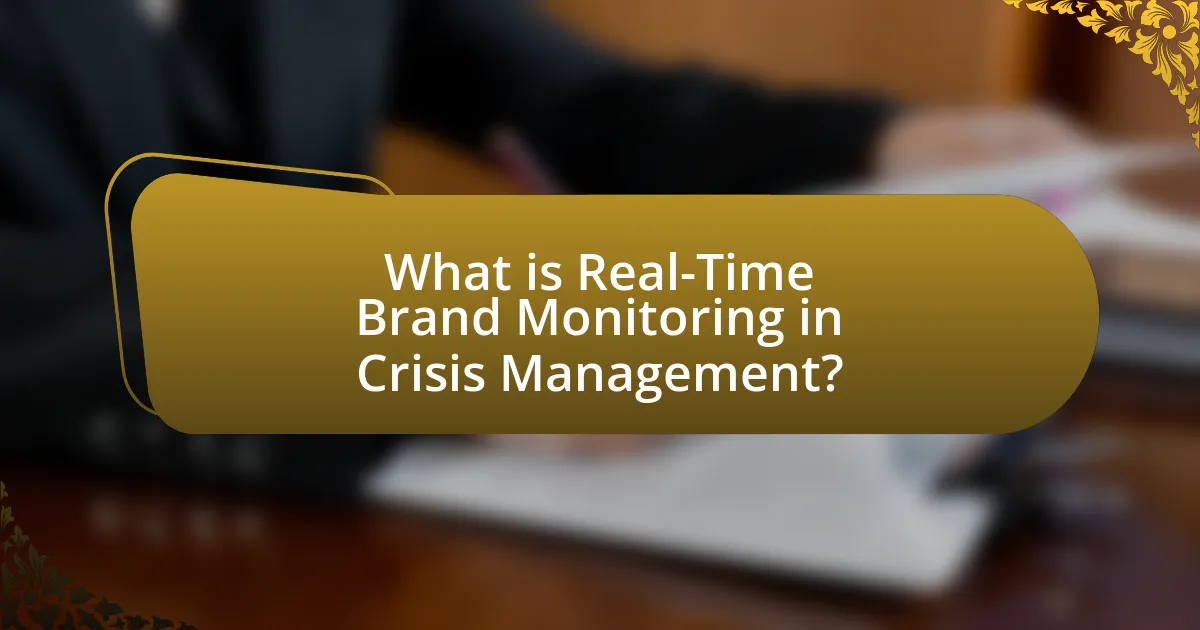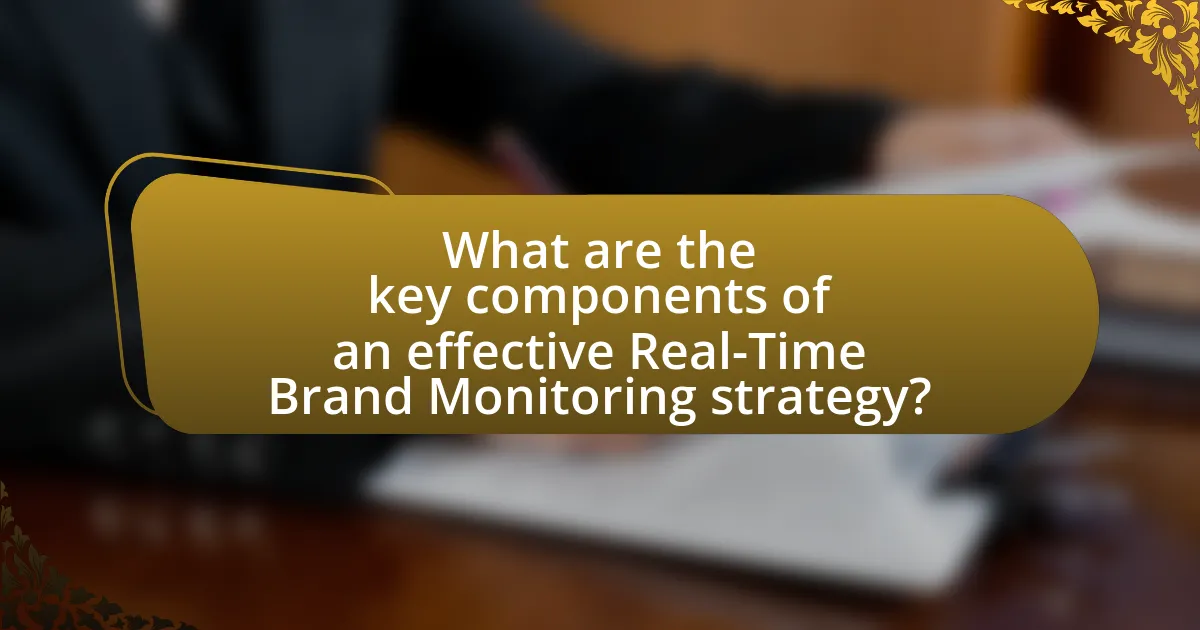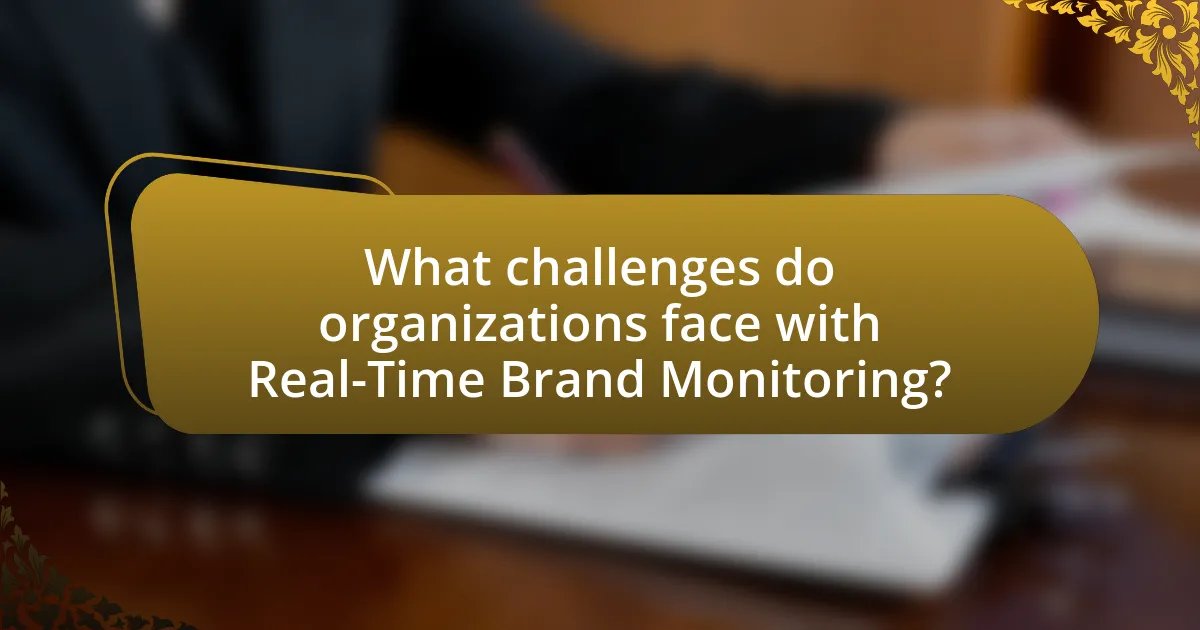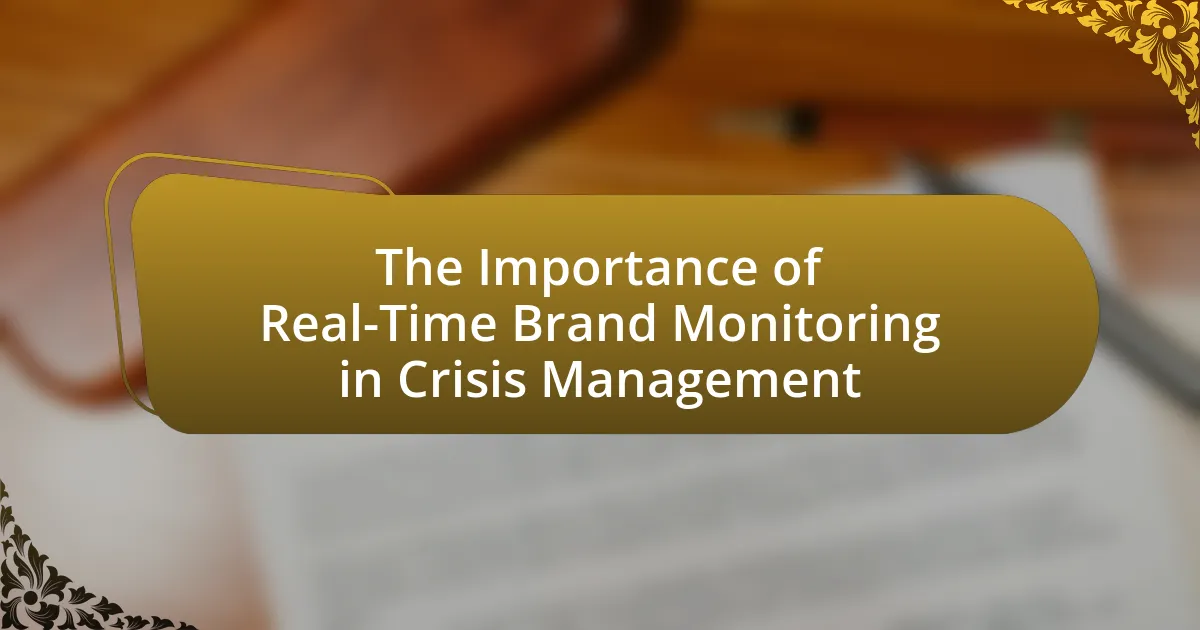Real-time brand monitoring is a critical practice in crisis management that involves the continuous tracking and analysis of brand mentions across various media channels. This approach enables organizations to swiftly identify and respond to potential crises, mitigating reputational damage and maintaining customer trust. The article outlines the functioning of real-time brand monitoring during crises, essential tools for effective monitoring, and the integration of these tools into crisis management strategies. It also discusses the importance of timely insights, potential consequences of neglecting brand monitoring, and best practices for continuous improvement in monitoring processes. Additionally, the article highlights the role of stakeholder communication in enhancing brand reputation during critical situations.

What is Real-Time Brand Monitoring in Crisis Management?
Real-time brand monitoring in crisis management refers to the continuous tracking and analysis of brand mentions across various media channels to identify and respond to potential crises as they arise. This practice enables organizations to detect negative sentiment, misinformation, or emerging issues that could harm their reputation. According to a study by the Harvard Business Review, companies that engage in real-time monitoring can reduce the impact of crises by up to 50% through timely interventions. By leveraging tools that analyze social media, news outlets, and online forums, brands can swiftly address concerns, manage public perception, and maintain trust with their audience.
How does Real-Time Brand Monitoring function during a crisis?
Real-time brand monitoring functions during a crisis by continuously tracking and analyzing online conversations, social media mentions, and news coverage related to a brand. This process enables companies to identify emerging issues, gauge public sentiment, and respond swiftly to mitigate damage. For instance, a study by the Institute for Public Relations found that brands that actively monitor their reputation can reduce negative sentiment by up to 30% during a crisis. By leveraging analytics tools, organizations can pinpoint specific triggers of public concern and tailor their communication strategies accordingly, ensuring timely and effective responses.
What tools are essential for effective Real-Time Brand Monitoring?
Essential tools for effective Real-Time Brand Monitoring include social media monitoring platforms, sentiment analysis tools, and analytics dashboards. Social media monitoring platforms like Hootsuite and Brandwatch allow brands to track mentions and engagement across various channels in real-time. Sentiment analysis tools, such as Lexalytics and MonkeyLearn, help assess public perception by analyzing the tone of conversations surrounding the brand. Analytics dashboards, like Google Analytics and Sprout Social, provide insights into website traffic and social media performance, enabling brands to respond swiftly to emerging issues. These tools collectively facilitate timely responses to brand-related crises, ensuring that brands can manage their reputation effectively.
How do these tools integrate with crisis management strategies?
Real-time brand monitoring tools integrate with crisis management strategies by providing immediate insights into public sentiment and emerging issues. These tools enable organizations to detect potential crises early through social media monitoring, sentiment analysis, and trend tracking, allowing for timely responses. For instance, a study by the Institute for Public Relations found that organizations that utilize real-time monitoring can reduce the impact of a crisis by up to 50% by addressing issues before they escalate. This proactive approach ensures that brands can manage their reputation effectively during critical situations.
Why is Real-Time Brand Monitoring crucial in crisis situations?
Real-time brand monitoring is crucial in crisis situations because it enables organizations to quickly identify and respond to negative sentiments or misinformation. This immediate awareness allows brands to mitigate potential damage to their reputation and maintain customer trust. For instance, a study by the Harvard Business Review found that companies that respond to crises within the first hour can reduce the negative impact on their brand by up to 50%. By leveraging real-time data, brands can tailor their communication strategies effectively, ensuring that they address concerns promptly and accurately.
What are the potential consequences of neglecting brand monitoring during a crisis?
Neglecting brand monitoring during a crisis can lead to severe reputational damage and loss of customer trust. Without real-time insights, companies may fail to address negative sentiments or misinformation, resulting in escalated public backlash. For instance, a study by the Harvard Business Review found that brands that respond quickly to crises can mitigate damage by up to 50%. Additionally, neglecting brand monitoring can hinder a company’s ability to adapt its communication strategy, leading to misalignment with public expectations and further exacerbating the crisis. This lack of responsiveness can ultimately result in decreased sales and long-term financial losses, as seen in cases like United Airlines’ passenger incident in 2017, where delayed responses significantly harmed their reputation and stock value.
How can timely insights from brand monitoring mitigate damage?
Timely insights from brand monitoring can mitigate damage by enabling organizations to respond quickly to negative sentiment or misinformation. When brands actively monitor their reputation, they can identify potential crises early, allowing for swift corrective actions. For instance, a study by Sprout Social found that 70% of consumers are more likely to support a brand that responds to negative comments within 24 hours. This rapid engagement can prevent escalation, protect brand equity, and maintain customer trust.

What are the key components of an effective Real-Time Brand Monitoring strategy?
An effective Real-Time Brand Monitoring strategy consists of data collection, sentiment analysis, response management, and performance metrics. Data collection involves gathering information from various online sources, including social media, blogs, and news sites, to track brand mentions. Sentiment analysis assesses the emotional tone of these mentions, helping brands understand public perception. Response management ensures timely and appropriate engagement with audiences, addressing concerns or feedback. Performance metrics evaluate the effectiveness of the monitoring strategy, using key performance indicators (KPIs) to measure impact and inform future actions. These components work together to provide brands with actionable insights, enabling them to manage their reputation proactively during crises.
What metrics should be tracked for effective brand monitoring?
Effective brand monitoring requires tracking metrics such as brand sentiment, share of voice, engagement rates, and brand mentions. Brand sentiment measures public perception through positive, negative, or neutral sentiments expressed in social media and reviews, which can indicate potential crises or brand health. Share of voice compares a brand’s mentions to competitors, providing insight into market position and visibility. Engagement rates assess how audiences interact with brand content, reflecting the effectiveness of communication strategies. Brand mentions quantify how often a brand is discussed across various platforms, helping identify trends and emerging issues. Collectively, these metrics enable brands to respond proactively to potential crises and maintain a positive reputation.
How do sentiment analysis and engagement metrics contribute to crisis management?
Sentiment analysis and engagement metrics are crucial for effective crisis management as they provide real-time insights into public perception and response. By analyzing sentiment, organizations can gauge the emotional tone of conversations surrounding a crisis, allowing them to identify potential issues early and adjust their communication strategies accordingly. Engagement metrics, such as shares, comments, and likes, indicate how audiences are interacting with the brand during a crisis, helping to assess the effectiveness of the response and the level of public concern. For instance, a study by the Harvard Business Review found that companies that actively monitored sentiment and engagement during crises were able to mitigate negative impacts and recover their reputations more swiftly.
What role does social media play in brand monitoring metrics?
Social media serves a critical role in brand monitoring metrics by providing real-time insights into consumer sentiment and brand perception. It enables brands to track mentions, engagement levels, and feedback across various platforms, allowing for immediate response to potential crises. According to a 2021 report by Sprout Social, 70% of consumers expect brands to respond to their inquiries on social media within an hour, highlighting the necessity for brands to actively monitor these channels to maintain a positive image and address issues promptly. This data-driven approach to brand monitoring through social media not only aids in crisis management but also informs strategic decision-making and enhances customer relationships.
How can organizations implement Real-Time Brand Monitoring?
Organizations can implement Real-Time Brand Monitoring by utilizing advanced analytics tools and social media listening platforms. These tools enable organizations to track brand mentions, sentiment, and engagement across various digital channels in real-time. For instance, platforms like Hootsuite and Brandwatch provide dashboards that aggregate data from social media, blogs, and news sites, allowing organizations to respond swiftly to emerging issues. According to a report by Sprout Social, 70% of consumers expect brands to respond to their inquiries within an hour, highlighting the necessity for timely monitoring. By integrating these tools with alert systems, organizations can ensure they are notified immediately of any significant brand-related conversations, facilitating proactive crisis management.
What steps are involved in setting up a brand monitoring system?
To set up a brand monitoring system, the first step is to define the objectives and key performance indicators (KPIs) that will guide the monitoring efforts. This involves identifying what aspects of the brand’s reputation, customer sentiment, and market trends are most critical to track. Next, select the appropriate tools and platforms for monitoring, such as social media listening tools, web analytics, and review aggregators, which can provide real-time data on brand mentions and sentiment.
After selecting the tools, configure them to track relevant keywords, phrases, and competitors, ensuring that the system captures a comprehensive view of brand perception across various channels. The fourth step is to establish a process for analyzing the collected data, which includes setting up alerts for significant changes in sentiment or volume of mentions. Finally, create a reporting framework to regularly share insights with stakeholders, allowing for timely responses to potential crises and informed decision-making.
These steps are essential for effective brand monitoring, as they enable organizations to proactively manage their reputation and respond to issues before they escalate.
How can organizations train their teams to respond to monitoring insights?
Organizations can train their teams to respond to monitoring insights by implementing structured training programs that focus on data interpretation, communication strategies, and decision-making processes. These programs should include practical exercises that simulate real-time scenarios, allowing team members to practice responding to insights effectively. Research indicates that organizations that conduct regular training sessions see a 30% improvement in response times to monitoring insights, as reported by the Institute for Crisis Management. Additionally, incorporating feedback loops and performance assessments can enhance the learning experience, ensuring that teams continuously refine their skills in utilizing monitoring insights for crisis management.

What challenges do organizations face with Real-Time Brand Monitoring?
Organizations face several challenges with Real-Time Brand Monitoring, including data overload, sentiment analysis accuracy, and resource allocation. Data overload occurs when organizations receive vast amounts of information from multiple channels, making it difficult to identify relevant insights. Sentiment analysis accuracy is often compromised due to the nuances of language, leading to misinterpretations of public sentiment. Additionally, resource allocation becomes a challenge as organizations must invest in technology and skilled personnel to effectively monitor and respond to brand mentions in real time. These challenges can hinder an organization’s ability to manage its brand reputation effectively during crises.
What are common pitfalls in brand monitoring during a crisis?
Common pitfalls in brand monitoring during a crisis include delayed response times, lack of comprehensive data analysis, and failure to engage with stakeholders. Delayed response times can exacerbate negative perceptions, as timely communication is crucial in crisis management. A lack of comprehensive data analysis may lead to misinterpretation of public sentiment, resulting in misguided strategies. Additionally, failing to engage with stakeholders, including customers and employees, can create a disconnect that further damages brand reputation. These pitfalls highlight the necessity for proactive and real-time monitoring to effectively manage brand perception during crises.
How can misinformation affect brand monitoring efforts?
Misinformation can significantly hinder brand monitoring efforts by distorting public perception and complicating the analysis of brand sentiment. When false information circulates, it can lead to misinterpretations of consumer attitudes, making it challenging for brands to gauge their actual reputation. For instance, a study by the Pew Research Center found that 64% of Americans believe that misinformation has caused confusion about basic facts, which can skew brand monitoring data and lead to misguided strategic decisions. Consequently, brands may allocate resources to address issues that are not reflective of the true consumer sentiment, ultimately impacting their crisis management effectiveness.
What strategies can be employed to overcome these challenges?
To overcome challenges in real-time brand monitoring during crisis management, organizations can implement proactive communication strategies. These strategies include establishing a dedicated crisis management team that monitors social media and news outlets continuously, allowing for immediate response to emerging issues. Additionally, utilizing advanced analytics tools can help identify trends and sentiment shifts in real-time, enabling brands to adjust their messaging accordingly. Research indicates that companies employing these strategies can reduce negative sentiment by up to 30% during crises, demonstrating their effectiveness in managing brand reputation.
How does Real-Time Brand Monitoring evolve post-crisis?
Real-Time Brand Monitoring evolves post-crisis by shifting focus from immediate damage control to long-term reputation management and consumer engagement. After a crisis, brands utilize monitoring tools to analyze public sentiment and feedback, allowing them to identify lingering issues and address consumer concerns effectively. This evolution is supported by data indicating that 70% of consumers are more likely to trust brands that respond transparently to crises, highlighting the importance of ongoing engagement and communication. Additionally, brands often implement enhanced monitoring strategies, incorporating advanced analytics and AI technologies to predict potential future crises and adapt their strategies accordingly.
What lessons can be learned from monitoring data after a crisis?
Monitoring data after a crisis reveals critical lessons about brand perception and response effectiveness. Analyzing social media sentiment and engagement metrics can highlight public concerns and areas for improvement, as evidenced by the 2017 United Airlines incident, where real-time monitoring of customer feedback led to a swift public relations response that mitigated further damage. Additionally, tracking data trends can inform future crisis preparedness strategies, ensuring organizations can adapt quickly to emerging issues. This approach not only enhances brand resilience but also fosters trust among stakeholders by demonstrating accountability and responsiveness.
How can organizations adapt their strategies based on past crises?
Organizations can adapt their strategies based on past crises by conducting thorough analyses of previous events to identify weaknesses and strengths in their response. This involves reviewing crisis management protocols, assessing communication effectiveness, and evaluating stakeholder reactions. For instance, after the 2008 financial crisis, many organizations implemented more robust risk management frameworks and enhanced transparency to rebuild trust with stakeholders. By learning from specific failures, such as inadequate communication during the crisis, organizations can refine their real-time brand monitoring systems to better anticipate and respond to future challenges. This proactive approach not only mitigates risks but also strengthens overall resilience in crisis management.
What best practices should organizations follow for effective Real-Time Brand Monitoring?
Organizations should implement a multi-channel monitoring strategy for effective Real-Time Brand Monitoring. This involves tracking brand mentions across social media, news outlets, blogs, and forums to capture a comprehensive view of public sentiment. According to a study by Sprout Social, 70% of consumers expect brands to respond to their inquiries within an hour, highlighting the necessity for timely engagement. Additionally, utilizing advanced analytics tools can help organizations identify trends and sentiment shifts, enabling proactive responses to potential crises. Regularly updating monitoring parameters ensures that organizations stay relevant to emerging conversations, further enhancing their crisis management capabilities.
How can organizations ensure continuous improvement in their monitoring processes?
Organizations can ensure continuous improvement in their monitoring processes by implementing regular reviews and updates of their monitoring strategies. This involves analyzing performance metrics, gathering feedback from stakeholders, and integrating new technologies to enhance data collection and analysis. For instance, a study by McKinsey & Company found that organizations that adopt agile methodologies in their monitoring processes can improve responsiveness and adaptability, leading to better crisis management outcomes. By consistently evaluating and refining their monitoring approaches, organizations can stay ahead of potential crises and effectively manage their brand reputation.
What role does stakeholder communication play in brand monitoring success?
Stakeholder communication is crucial for brand monitoring success as it facilitates the flow of information between the brand and its key audiences. Effective communication with stakeholders, including customers, employees, and investors, allows brands to gather real-time feedback and insights, which are essential for identifying potential issues and trends. For instance, a study by the Institute for Public Relations found that organizations with strong stakeholder communication strategies are 50% more likely to successfully manage crises. This underscores the importance of maintaining open lines of communication to enhance brand reputation and responsiveness during critical situations.

Leave a Reply